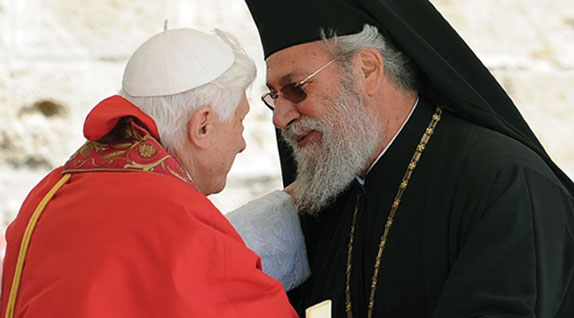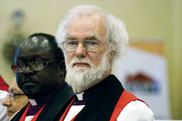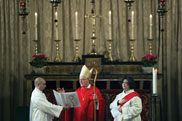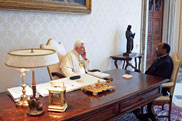 Alberto Pizzoli/AFP/Getty Images
Alberto Pizzoli/AFP/Getty Images
Article
Learn the why behind the headlines.
Subscribe to the Real Truth for FREE news and analysis.
Subscribe NowWhen Cardinal Joseph Ratzinger was chosen to succeed Pope John Paul II, he made one priority clear. His first written message as Benedict XVI on April 20, 2005, as reported by the official Catholic news agency, Zenit, stated “a primary commitment” was “to work without sparing energies for the reconstitution of the full and visible unity of all the followers of Christ.”
“Full and visible unity”—in a world grown so accustomed to thousands of Christian denominations and more arising each year, this may sound naive. Most would consider this a nice platitude or pleasant ideal, but ultimately impossible to achieve. Since the Great Schism of 1054 (separating Roman Catholic and Eastern Orthodox adherents) and the Protestant Reformation in the 16th and 17th centuries, visible disunity has defined Christendom.
What did Benedict mean when he made this statement? Did he have in mind merely “spiritual” unity, evidenced by friendly visits and joint efforts—all while keeping historical separations in place—or something more?
Unity, Catholic-style
More recently, the meaning of unity from the Catholic perspective has been clarified: “In the past 30 years, the Vatican has moved strongly to reassert the authority of a traditional, even orthodox Roman Catholicism—to bring the notion of a ‘one true church’ to Europe and then the larger world. The intent was to reverse the ‘open’ or liberalizing trend of the church represented by Vatican II…[it] has cracked down on liberation theology, affirmed traditional sexual morality, and is now quietly supporting ultradevout Catholic groups such as Opus Dei and the Legions of Christ—while curbing ecumenical outreach and describing Protestant churches as not authentic.
“The most constant, diligent, and serious champion of these moves is a shy but brilliant German theologian, [Joseph] Ratzinger—now Pope Benedict XVI.
 Marc Hofer/AFP/Getty Images
Marc Hofer/AFP/Getty Images Vicenzo Pinto/AFP/Getty Images
Vicenzo Pinto/AFP/Getty Images  Osservatore Romano/AFP/Getty Images
Osservatore Romano/AFP/Getty Images
“‘There is no great issue, no direction in Catholic theology, not dominated by Ratzinger over the past three decades,’ says Hermann Haring, a liberal Jesuit theologian who studied with Ratzinger and has written a book about his theology” (ABC News).
This pope is championing an old but revolutionary idea—“one true church.” How is this being received by the rest of the traditional Christian world? Are Protestant churches recoiling from such a seemingly radical suggestion?
Rome and the Lutherans
Although the Vatican’s doctrinal ecumenism may have been curtailed since reaching its high-water mark at the Second Vatican Council (known as Vatican II), the current pope has been highly active in building bridges to other denominations, increasing dialogue and strengthening ties.
On February 10, 2010, he “invited a Lutheran delegation from the United States to treasure the accomplishments of ecumenism and work so that full unity can one day be realized.
“The Pope made this invitation while greeting Lutheran Bishop Mark Hanson and the delegation accompanying him at the general audience in Paul VI Hall.
“‘Since the beginning of my pontificate, I have been encouraged that relations between Catholics and Lutherans have continued to grow, especially at the level of practical collaboration in the service of the Gospel’…He expressed hopes that ‘continuing Lutheran-Catholic dialogue both in the United States of America and at the international level will help to build upon the agreements reached so far.’
“The Bishop of Rome concluded citing words from Pope John Paul II, ‘during whose pontificate so much was accomplished on the road to full visible unity among Christians [emphasis added].’
“He said: ‘You are most welcome here. Let us rejoice that an encounter such as this can take place. Let us resolve to be open to the Lord so that he can use this meeting for his purposes, to bring about the unity that he desires. Thank you for the efforts you are making for full unity in faith and charity’” (Zenit).
Consider that the Lutheran church is named after Martin Luther. His public criticism of the Catholic church opened the floodgates of European dissent, setting the stage for the Protestant Reformation. In light of the new friendliness between Lutheran leaders and the Vatican, some staunch Protestants are convinced that the Reformation is now being reversed.
Reaching Out to Orthodox Leadership
June 2010 saw the pope address two branches of the Orthodox church. He received a delegation from Orthodox Patriarch Bartholomew I at the Vatican:
“Benedict XVI says that dialogue between Catholics and Orthodox is at a ‘crucial point’ and invited heartfelt prayer to the Holy Spirit for progress to continue.
“The visit reciprocates the habitual exchange of delegations for the respective patronal feasts in which the patriarch of Constantinople sends a delegation to Rome on June 29, the feast of Sts. Peter and Paul, and the Pope sends a delegation to Istanbul, Turkey, on Nov. 30, the feast of St. Andrew.”
“Today, the Orthodox delegation was led by Metropolitan Gennadios of Sassima (Limouris), who is the co-secretary of the International Mixed Commission for Theological Dialogue Between the Catholic Church and the Orthodox Church. [The pope] made reference to Tuesday’s feast of Sts. Peter and Paul as testifying to ‘a time when our communities were living in full communion with one another.’ Orthodox and Catholics celebrate the feast on the same day.
“He added that today’s visit, along with the ‘many meetings that have already taken place in the course of this year’ show how the ‘relations between us are characterized by sentiments of mutual trust, esteem and fraternity.’ This, the Pontiff said, ‘gives grounds for hope that Catholic-Orthodox dialogue will also continue to make significant progress’” (Zenit).
This topic of discussion is noteworthy, since it has been the primacy of the pope (also called the bishop of Rome) that has been the main issue of contention between Orthodox and Catholic believers.
“‘With all our hearts we pray that, enlightened by the Holy Spirit, the members of the commission will continue along this path during the forthcoming plenary session in Vienna, and devote to it the time needed for thorough study of this delicate and important issue,’ he said” (ibid.).
This meeting was preceded by an unprecedented visit to the island nation of Cyprus.
“Benedict is the first pope to visit Cyprus and this was his first trip to an Orthodox country, which raised eyebrows among more traditional religious men in the country and threats by some of them of a boycott [some hard-line Cypriot Orthodox clerics consider the pope a heretic].
“But his first stop after leaving the Paphos airport was the nearby ancient church of Agia Kyriaki Chrysopolitissa, where he was to take part in an ‘ecumenical celebration’ with [Orthodox Archbishop of Cyprus] Chrysostomos, who has called on people to welcome him” (Zenit).
Chrysostomos himself warmly welcomed the pontiff, saying in his greeting, “Your Holiness, Despite the small numbers of its flock, the Church of Cyprus holds an eminent position in Orthodoxy and enjoys fraternal relations with all the Churches. Indeed, as we enter the 21st century, which is the century of dialogue, approach and mutual understanding, we are determined to continue this course, in the belief that this is the will of the All-Merciful Lord. Once again we express our joy and sense of honor at having you here among us today” (ibid.).
Anglican Church in Crisis
Catholic overtures toward the church of England, which arose from a rift between English King Henry VIII and Pope Paul III in 1534, have arrived in an entirely different context. The Anglicans have seen divisions within their ranks over the issue of ordaining women and homosexuals as priests, and now there is further opposition to females holding the position of bishop.
“At a meeting of the Synod in York last month, the Archbishops of Canterbury and York failed in a last-ditch attempt to avoid a damaging split by making more concessions to traditionalists.
“As a result, many Anglo-Catholics are now considering whether to cross over to Rome en masse, under the terms of a new Anglican Ordinariate proposed by Pope Benedict XVI. This will allow them to enter into full communion with the Vatican while retaining parts of their Anglican heritage. Others may convert individually, as hundreds did when women priests were introduced.
“But the draft legislation decided upon in July must still be agreed by all 44 dioceses in England, and then voted through by a formidable two-thirds majority in each of Synod’s three ‘houses’—groups of laity, clergy and bishops—in 2012.
“The pastoral letter signed by the traditionalist bishops—including those of Chichester, Blackburn, Burnley and Whitby as well as [other] bishops—has been sent to 1,000 clergy in the Forward in Faith group who signed an earlier open letter warning of a mass exodus over the move to allow women prelates.
“It says these are ‘grave times’ in the Church and, although plans for a compromise have been rejected, they detect a ‘measure of disquiet in the majority about proceeding without a provision acceptable to traditionalists.’
“The bishops say some ‘trailblazers’ have already resolved to join the Ordinariate and that many more will need to ‘consider seriously’ crossing the Tiber [a term describing those who leave Anglicanism to become Catholic] if the current plan to introduce women bishops goes ahead, with the first female expected to don a mitre in 2014 at the earliest” (The Telegraph).
This is a remarkable development—an unprecedented arrangement in modern times for such large organizations. It in effect creates a “church within a church,” a situation that is ultimately unsustainable. These “Anglo-Catholics” cannot remain both Anglican (acknowledging the English monarch as head of the church) and Catholic (submitting to the pope). They will eventually have to choose.
Beyond Christianity
While Benedict has now engaged some of the largest Protestant and Orthodox denominations, relations with other major religions have been strained.
He drew an angry reaction from Muslims in 2006 when, speaking at his alma mater, the University of Regensburg, he quoted an old text that described Islam as irrational and violent. He has made efforts to atone for this in the years since: “Vatican spokesman…Federico Lombardi was asked afterwards whether the Pope’s view on Islam has changed since Regensburg. ‘It’s a journey, there’s progress,’ he said. ‘We have to learn from what the Muslims tell us about Islam’” (Time).
During his visit to Cyprus, the pope said that “the murder of the head of the Roman Catholic Church in Turkey earlier this week should not cloud dialogue with Islam” (Agence France-Presse). The slaying, perpetrated by a man with a history of mental illness, is not believed to have been motivated by religion. But it has not helped Muslim-Christian relations in predominantly Islamic Turkey.
Jewish leaders have also found reason to be upset with the Vatican, as the process of naming wartime Pope Pius XII a saint proceeds, pushed along by Pope Benedict himself. Many in the Jewish community contend that Pius did not put forth sufficient effort to help European Jews trapped under the Nazi jackboot in Europe during World War II. The Vatican’s spokesman commented that the move toward his sainthood “is in no way to be read as a hostile act towards the Jewish people, and it is to be hoped that it will not be considered as an obstacle on the path of dialogue between Judaism and the Catholic Church” (The New York Times).
Mideast Focal Point
The pontiff’s interest in all of Christianity, as well as Islam and Judaism, has naturally led him to focus on the region in which these three belief systems meet—the Middle East.
After he received the Orthodox delegation, the pope “went on to speak of the importance of the theme of unity for the synod on the Middle East, which will be held in Rome in October.
“‘The difficulties that the Christians of the Middle East are experiencing are in large measure common to all: living as a minority, and yearning for authentic religious freedom and for peace,’ he said” (Zenit).
On the way to Cyprus, Benedict spoke of overcoming differences between peoples—his visit followed the Gaza flotilla incident in June—and divides between religions as well.
“Referring to the latest troubles in the Middle East, the pope told reporters aboard his flight: ‘In all of these episodes we have been living through, there has always been the danger that people lose patience and say: ‘I no longer want to seek peace.’
“‘In the face of each instance of violence, you must not lose patience or courage…You always have to begin again afresh in the certainty that you can go forward and achieve peace.’
“Unveiling the pope’s program, Vatican spokesman Federico Lombardi said ‘peace will be the key of this trip,’ emphasizing unity among Christian churches and ecumenism” (ibid.).
Real Unity!
When the pope speaks of unity, he means unification. Beyond dialogue, cheerful greetings and warm sentiments, Rome will move to heal centuries-old rifts, and bring many Orthodox and Protestant followers back into the Catholic fold.
Difficult? Yes, but not impossible. The process will involve a number of pressures and developments converging: the prospect of Europe becoming a majority-Muslim continent; the global economic crisis, prompting the rise of a new stabilizing force to replace the United States; and striking, miraculous displays of power that will convince many that God is only working in this universal church.
Keep watching as historical divisions dissolve, bringing to pass Pope Benedict’s intent of “full and visible unity.”


